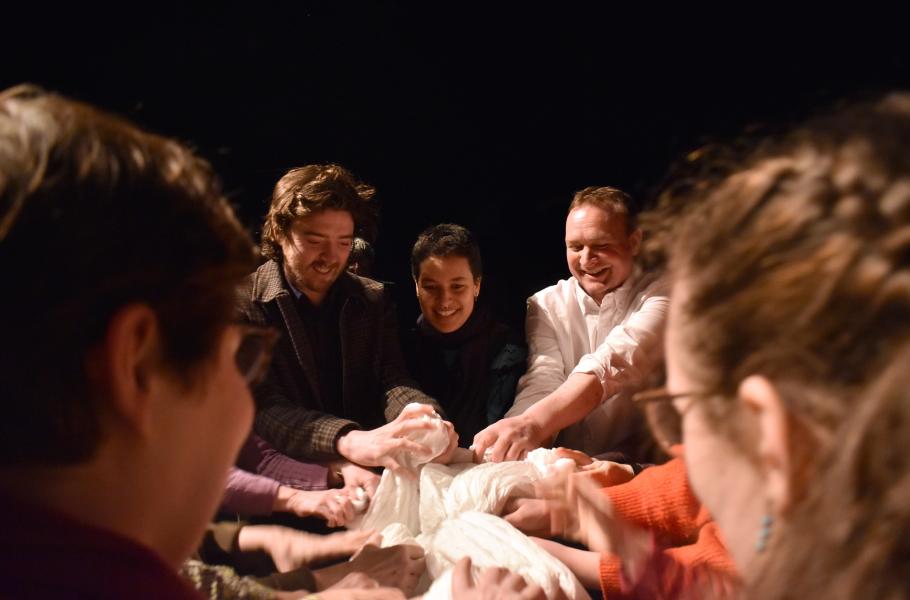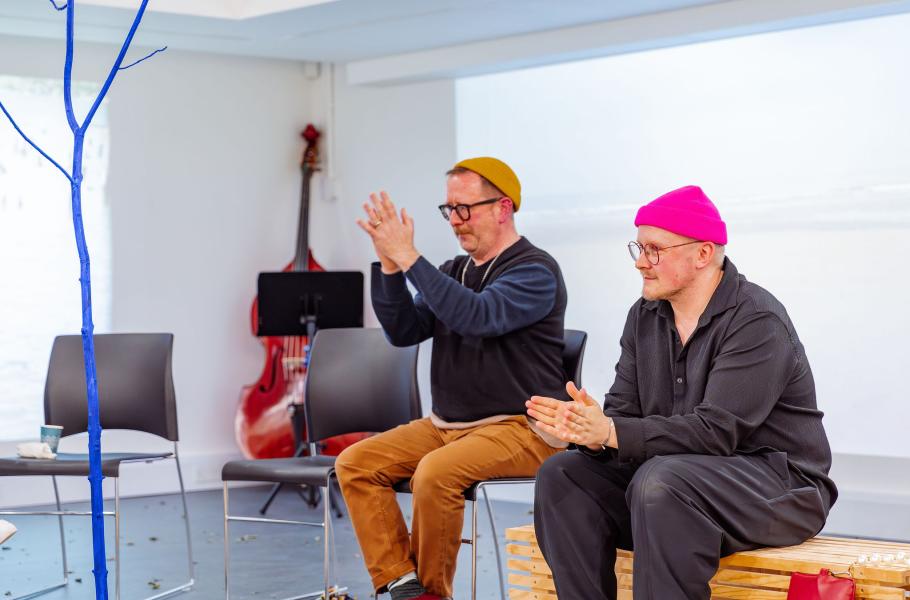Bringing the Outside In: Landscapes, Objects, and the Stories They Hold
In November 2025, Lancaster Arts hosted a participatory workshop and conversation, that was a part of the Festival of Social Science and facilitated by Prof Imogen Tyler. This was entitled Landscape: Bringing the Outside In and the Inside Out and took place at the Strathmore Hotel in Morecambe. The event explored findings from Lancaster Arts year-long theme of LAND, and gave participants the chance to explore their own relationships to land and landscapes.
Two artists from our TEST Residencies on LAND, Kate Fox and Ellie Harrison, were invited to share their practice and deliver creative exercises as part of the session.
Alice Booth, Producer at Lancaster Arts, wrote the following blog in response to the event.
This event was an opportunity to revisit some of the questions we’ve been exploring throughout the year: How do we find our place in a landscape, shape it, and allow it to shape us? How do personal, biographical, social, and political histories of land inform our sense of belonging—or not belonging—to the places we move through? And what is the relationship between physical, imaginary, and inner landscapes?
Against this backdrop, the gathering brought together artists, researchers, and members of the public to explore how we connect to place, and how those connections move between imagination and environment, emotion and geography. What unfolded was less a formal discussion than a slow, shared revealing of stories, memories, and moments of quiet recognition.
Participants were invited to bring an object to the session that connected them to land or landscape. The room soon filled with stones, shells, feathers, and small tokens, each carrying its own tale. For many, these objects were not just mementoes but living connections - what one participant called “talismanic things, holding the vibe of a place.” A smooth granite pebble recalled the moorland of childhood; a broken glass globe that once held water evoked wild swimming, along with experiences of disability and pregnancy. Others described memory itself as a kind of object, something that can be held and revisited when physical return is impossible.
Throughout the afternoon, the conversation circled around the relationship between what is outside and what is within our bodies. Some reflected on the intimacy of landscape, how it shapes the body and imagination, while others spoke of how interior worlds spill back out into the land through art, activism, and care. “There’s a dynamic flow between inner and outer worlds,” one artist said. “Landscapes find their way in.”
For several participants, this was also about belonging and displacement. Migrants and travellers shared how new environments unsettle and remake identity, while others described how landscapes of memory continue to anchor them long after they have moved away. “How do we find our place in a new landscape when our origin landscape still holds our heart?” asked one contributor, capturing the tender tension at the centre of the afternoon.
Kate Fox’s poetry reading expanded this conversation into the realm of biology. “I am 38 trillion bacteria cells and 30 trillion human cells,” she said. “I am calcium that floated in Cretaceous seas before becoming Yorkshire limestone.” Her words reminded us that the boundary between human and landscape is more porous than it seems, a theme also raised by artist Louise Ann Wilson, whose work explores the body-landscape connection through rock and terrain (Louise’s exhibition was recently installed in the Peter Scott Gallery, Lancaster Arts. More information can be found here).
That sense of porousness, of blurring rather than defining, resonated with the ethos of Lancaster Arts’ TEST Residencies, which resist the pressure to produce pre-determined outputs. Director of Lancaster Arts, Jocelyn Cunningham explained that these residencies are “about holding complex spaces, not simplifying them.” Inquiry, not product, is the goal.
That openness allowed emotion to surface too. One participant spoke candidly about the grief and frustration of living through ecological crisis. “I feel overwhelmed by what’s happening to everything out there,” they said. “I want to find ways to help without alienating people.” The comment lingered, giving way to a discussion about how to inspire care without shame, how to make space for hope.
Later, the focus turned to mapping, each participant sketching the landscapes of their lives: childhood fields, teenage streets, adult homes. What emerged were not static maps but living stories. “Spaces layer up meanings in our lives,” said Ellie Harrison, the artist leading the creative activity. “If we made a map for every year, we would have an autobiography of layers, a palimpsest.”
As people compared their maps, fascinating patterns appeared. Some found themselves drawing the same kinds of spaces repeatedly, recreating familiar shapes of belonging wherever they lived. “I realised my comfort zone, my anchor point, has repeated itself across continents,” one person observed. “I have been rebuilding the same coastline again and again.” Others noted how people, not places, often gave maps their emotional force. “There was a person in nearly everyone’s drawing,” someone remarked. “The feelings we have about a place come from those relationships.”
The conversation deepened into questions of movement, memory, and inheritance. “Although we think of a place as fixed,” said another participant, “it is all moving all the time.” The act of mapping became a meditation on what we inherit, from parents, from history, from the land itself, and how we navigate between rootedness and drift.
Several spoke about safety as a precondition for memory. “To lay down memories, we need to feel safe,” one participant reflected. “When a person made a place feel safe, that is when we remembered it.” Others connected this to displacement, those who cannot return to familiar ground through illness, conflict, or exile. “It feels like a privilege to be comfortable in a place,” someone said quietly. “But what if you cannot? There are so many who cannot.”
As the discussion turned toward what might come next, a series of ideas and tensions surfaced: the call for “open-handed, non-possessiveness*” when engaging with the natural world, the role of protest and performance, and the courage to take on slow, visible acts of resistance. One participant referenced an activist who dressed as a turtle to draw attention to pollution in the seas - a reminder that sometimes change requires both vulnerability and persistence. Participants also spoke about the need to reimagine urban and built landscapes with care. “Too often housing is imposed without thought for how people inhabit the land around them,” one participant noted. “Planting more trees once improved public health in London. We forget how directly landscape shapes us.”
Another speaker offered a gentle shift in perspective. “We have talked a lot about what nature does for us, but maybe we should also ask what it is trying to teach us, if we can learn to listen.”
The afternoon ended not with answers but with a shared act of remembrance. Participants were invited by poet Kate Fox to speak a single sentence beginning with the words “and also,” a phrase that captured both continuity and unfinishedness.
One by one, voices offered fragments into the collective landscape:
“And also, our maps have people in them.”
“And also, unresolved questions and confusions.”
“And also, kinaesthetic knowledge and the ghost of dance.”
“And also, a twist in the woods, a twist of the arm, a twist in the path across the field.”
“And also, mind blown by the complexity and depth of so many different ideas.”
“And also, a place to live.”
It was a fitting close, a mosaic of impressions rather than conclusions. In that shared rhythm, the room seemed to breathe as one landscape, shifting, layered, alive.
As one participant put it near the end, “We have created a landscape here this afternoon, since we stepped in from outside at three o’clock.” And indeed, we had, a landscape made of stories, memories, and questions still unfolding, where the outside had been brought in, and the inside, for a moment, found its way out.
* Open-handed nonpossessiveness, a term coined by philosopher John Llewelyn, describes meeting others—people, animals, or the natural world—without trying to control or use them. It’s a way of being open enough to truly encounter things as they are, a generous form of respect that recognises the world doesn’t belong to us yet still meets us in its own way.
We will be exploring the theme of LAND for the rest of 2025. As well as Louise Ann Wilson’s exhibition mentioned above, we are presenting James Fox and Dave Shooter, Could We Dream in Colour, which reimagines land, ownership, and borders through creative practice, and proposes more inclusive and communal ways of relating to place. As a sharply political set of perspectives this final exhibition of the year bridges to Lancaster Arts 2026 theme of Dissent. We are hosting a public event on 4 December with music and dance in the gallery entitled ‘If I can’t dance to it, it’s not my revolution’ a quote by anarchist Emma Goldman. See also our LAND themed performances as part of our concert and theatre programmes. We hope to see you there.




